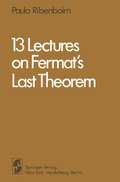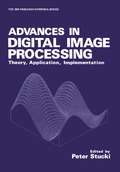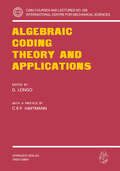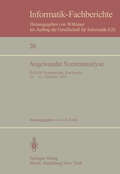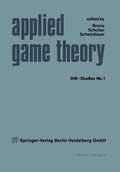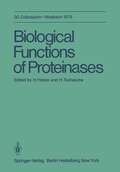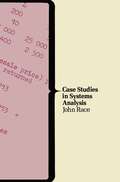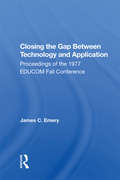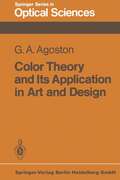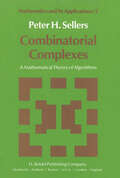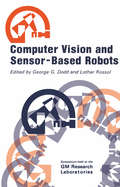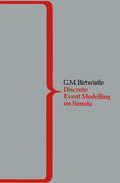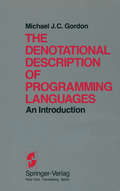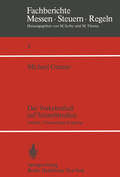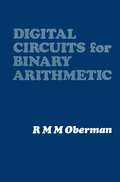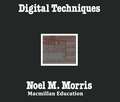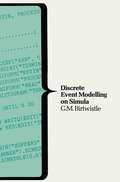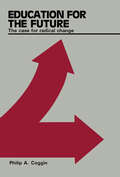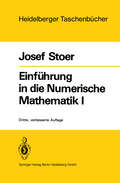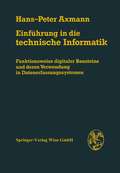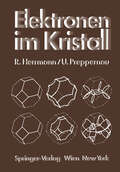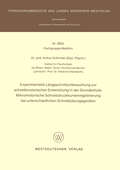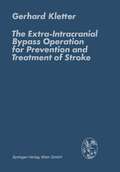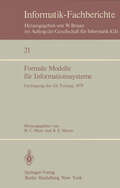- Table View
- List View
Advances in Digital Image Processing: Theory, Application, Implementation
by P. StuckiDigital image processing, originally established to analyze and improve lunar images, is rapidly growing into a wealth of new appli cations, due to the enormous technical progress made in computer engineering. At present, the most important fields of growth appear to emerge in the areas of medical image processing (i. e. tomography, thermography), earth resource inventory (i. e. land usage, minerals), office automation (i. e. document storage, retrieval and reproduction) and industrial production (i. e. computer vision for mechanical ro bots). Currently, emphasis is being shifted from signal-processing re search and design-innovation activities towards cost-efficient system implementations for interactive digital image processing. For the years ahead, trends in computer engineering indicate still further advances in Large Scale Integration (LSI) and Input/Output (I/O) technologies allowing the implementation of powerful parallel and/or distributed processor architectures for real-time processing of high resolution achromatic and color images. In view of the many new developments in the field of digital image processing and recognizing the importance of discussing these developments amongst key scientists that might make use of them, ffiM Germany sponsored an international symposium on 'Advances in Digital Image Processing', held at Bad Neuenahr, Federal Republic of Germany, September 26 - 28, 1978. The interest shown in this symposium encouraged the publi cation of the papers presented in this volume of the ffiM Research Symposium Series.
Algebraic Coding Theory and Applications (CISM International Centre for Mechanical Sciences)
by Carlos R. Hartmann Giuseppe LongoAngewandte Szenenanalyse: DAGM Symposium, Karlsruhe 10.–12. Oktober 1979 (Informatik-Fachberichte #20)
by Jörgen P. FoithApplied Game Theory: Proceedings of a Conference at the Institute for Advanced Studies, Vienna, June 13–16, 1978
by X. Y. Brams X. Y. Schotter X. Y. SchwödlauerBiological Functions of Proteinases: 30. Colloquium, 26.-28. April 1979 (Colloquium der Gesellschaft für Biologische Chemie in Mosbach Baden #30)
by H. Holzer H. TschescheClosing The Gap Between Technology And Application
by James C. EmeryThis book presents analyses, from three points of view, of the use of computing technology in higher education. It considers application areas including office automation, distributed academic computing, distributed administrative computing, instructional systems, and information resources.
Closing The Gap Between Technology And Application
by James C. EmeryThis book presents analyses, from three points of view, of the use of computing technology in higher education. It considers application areas including office automation, distributed academic computing, distributed administrative computing, instructional systems, and information resources.
Color Theory and Its Application in Art and Design (Springer Series in Optical Sciences #19)
by George A. AgostonMy aim in this introductory text is to present a comprehensible discussion of certain technical topics and recent developments in color science that I believe are of real interest to artists and designers. I treat a number of applications of this knowledge, for example in selection and use of colorants (pigments and dyes) and light. Early in the book I discuss what color is and what its characteristics are. This is followed by a chapter on pertinent aspects of light, light as the stimulus that causes the perception of color. Then the subject of the colors of opaque and transparent, nonfluorescent and fluorescent materials is taken up. There are sections on color matching, color mixture, and color primaries. Chapter 6 introduces the basic ideas that underlie the universal method (CIE) of color specification. Later chapters show how these ideas have been extended to serve other purposes such as systematic color naming, de termining complementary colors, mixing colored lights, and demonstrating the limitations of color gamuts of colorants. The Munsell and the Ostwald color systems and the Natural Colour System (Sweden) are explained, and the new Uniform Color Scales (Optical Society of America) are described. Color specification itself is a broad topic. The information presented here is relevant in art and design, for those who work with pigments and dyes or with products that contain them, such as paints, printing inks, plastics, glasses, mosaic tesserae, etc.
Combinatorial Complexes: A Mathematical Theory of Algorithms (Mathematics and Its Applications #2)
by P.H. SellersIt isn't that they can't see the Approach your problems from the right end and begin with the solution. It is that they can't see answers. Then, one day, perhaps the problem. you will find the final question. 'The Hermit Clad in Crane Feathers' G. K. Chesterton, The scandal of in R. Van Gulik's The Chinese Maze Father Brown "The point of a Murders. pin" Growing specialization and diversification have brought a host of monographs and textbooks on increasingly specialized topics. However, the 'tree' of knowledge of mathematics and related fields does not grow only by putting forth new branches. It also happens, quite often in fact, that branches which were thought to be com pletely disparate are suddenly seen to be related. Further, the kind and level of sophistication of mathematics applied in various sciences has changed drastically in recent years: measure theory is used (non-trivially) in regional and theoretical economics; algebraic geometry interacts with physics; the Minkowsky lemma, coding theory and the structure of water meet one another in packing and covering theory; quantum fields, crys tal defects and mathematical programming profit from homotopy theory; Lie algebras are relevant to filtering; and prediction and electrical engineering can use Stein spaces.
Computer Vision and Sensor-Based Robots
by C.H. DoddThe goal ofthe symposium, "Computer Vision and Sensor-Based Robots," held at the General Motors Research Laboratories on September 2S and 26, 1978, was to stimulate a closer interaction between people working in diverse areas and to discuss fundamental issues related to vision and robotics. This book contains the papers and general discussions of that symposium, the 22nd in an annual series covering different technical disciplines that are timely and of interest to General Motors as well as the technical community at large. The subject of this symposium remains timely because the cost of computer vision hardware continues to drop and there is increasing use of robots in manufacturing applications. Current industrial applications of computer vision range from simple systems that measure or compare to sophisticated systems for part location determination and inspection. Almost all industrial robots today work with known parts in known posi tions, and we are just now beginning to see the emergence of programmable automa tion in which the robot can react to its environment when stimulated by visual and force-touch sensor inputs. As discussed in the symposium, future advances will depend largely on research now underway in several key areas. Development of vision systems that can meet industrial speed and resolution requirements with a sense of depth and color is a necessary step.
The Denotational Description of Programming Languages: An Introduction
by M.J.C. GordonThis book explains how to formally describe programming languages using the techniques of denotational semantics. The presentation is designed primarily for computer science students rather than for (say) mathematicians. No knowledge of the theory of computation is required, but it would help to have some acquaintance with high level programming languages. The selection of material is based on an undergraduate semantics course taught at Edinburgh University for the last few years. Enough descriptive techniques are covered to handle all of ALGOL 50, PASCAL and other similar languages. Denotational semantics combines a powerful and lucid descriptive notation (due mainly to Strachey) with an elegant and rigorous theory (due to Scott). This book provides an introduction to the descriptive techniques without going into the background mathematics at all. In some ways this is very unsatisfactory; reliable reasoning about semantics (e. g. correctness proofs) cannot be done without knowing the underlying model and so learning semantic notation without its model theory could be argued to be pointless. My own feeling is that there is plenty to be gained from acquiring a purely intuitive understanding of semantic concepts together with manipulative competence in the notation. For these equip one with a powerful conceptua1 framework-a framework enabling one to visualize languages and constructs in an elegant and machine-independent way. Perhaps a good analogy is with calculus: for many practical purposes (e. g. engineering calculations) an intuitive understanding of how to differentiate and integrate is all that is needed.
Der Verkehrsfluß auf Schnellstraßen: Modelle, Überwachung, Regelung (Fachberichte Messen - Steuern - Regeln #3)
by M. CremerEducation for the Future: The Case for Radical Change
by Philip A. CogginEducation for the Future: The Case for Radical Change focuses on the developments in educational systems and the role of teachers and learning institutions in shaping society. The book first ponders on the problems confronting progress in education, including the pressure on schools and teachers to perform according to the dictates of society. The need to develop curriculum in universities that can instill efficient learning for students is also underscored. The text also takes a look at the relationship of literary culture and the productive and distributive activities of the market place. The manuscript focuses on the influence of educational technology in the provision of aids in learning. The text also underscores that the solution to the problems of education in Britain should not be taken individually, but rather it should be treated as part of a larger pattern. The controversy in the establishment of the Gresham College is noted. The book is a dependable reference for readers interested in studying the development, issues, and trends in the educational system of Great Britain.
Einführung in die Numerische Mathematik I: unter Berücksichtigung von Vorlesungen von F.L. Bauer (Heidelberger Taschenbücher #105)
by J. StoerEinführung in die technische Informatik: Funktionsweise digitaler Bausteine und deren Verwendung in Datenerfassungssystemen
by H.-P. AxmannExperimentelle Längsschnittuntersuchung zur schreibmotorischen Entwicklung in der Grundschule. Mikromotorische Schreibdruckkurvenregistrierung bei unterschiedlichen Schreibübungsgeräten (Forschungsberichte des Landes Nordrhein-Westfalen)
by Arthur SchirmerThe Extra-Intracranial Bypass Operation for Prevention and Treatment of Stroke
by G. KletterA decade has passed since systematic studies were initiated in the USA in an attempt at establishing the experimental basis for a surgical technique which was to prove an effective tool in combatting one of the most common diseases, i.e. cerebrovascular accidents. The development of such intricate vasculosurgical techniques as are required for extra intracranial arterial bypass operations would not have been possible without the aid of the surgical microscope, which had been designed some years earlier. In the past few years increasing emphasis has been placed on establishing clear-cut indications for the bypass operation, because satisfactory long-term results are unlikely to be obtained without them. Needless to say that this requires a close cooperation of the neurosurgeon with a team composed of neurologists, internists, radiologists, and pathologists. Fortunately enough, cooperation between the services of the University of Vienna Medical School proved to be exemplary. While there has been no lack of efforts by major medical centers both in Europe and the overseas countries to perfect bypass operations for cerebrovascular accidents, a comprehensive monograph reviewing all medical and operative problems involved in microvascular surgery for strokes was badly missed by many.
